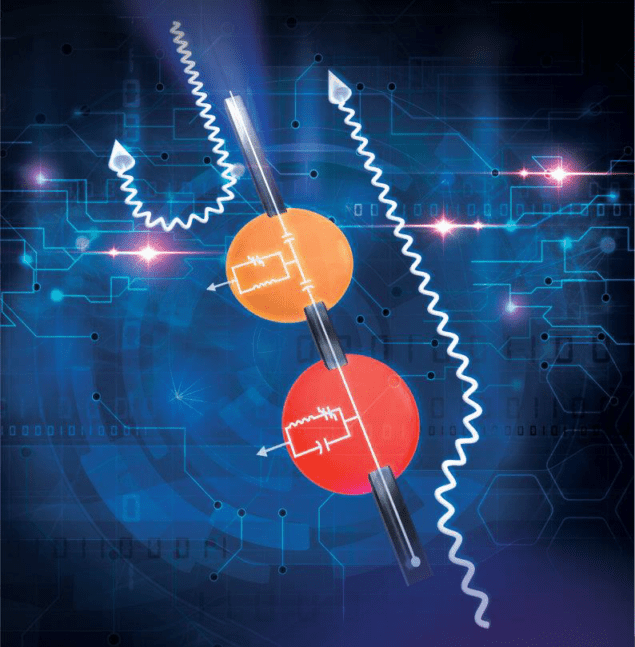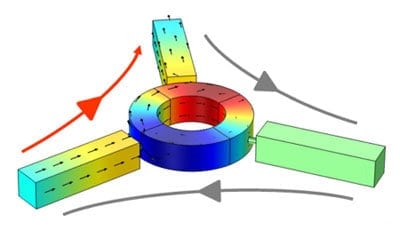
Most devices for the transmission of electromagnetic signals obey Lorentz reciprocity, meaning that signals propagate freely in both directions through circuits. A microwave pulse, for example, can travel in either direction along a waveguide and a light signal can move both ways along an optical fibre. This two-way traffic can cause problems and current technologies for avoiding reciprocity tend to be large and unwieldy. But now physicists in the US have come up with a more practical solution.
Lorentz reciprocity creates challenges for circuit designers because backward-propagating reflections can inject noise into circuits and even damage devices such as lasers. Isolators currently used in radar microwave transmitters, for example, get around this problem using a large external magnetic field. Waves propagating in the opposite direction see the opposite field and are therefore affected differently. However, this requires large, heavy magnets and adds considerably to the circuit’s power consumption. While nonmagnetic isolators have been developed, their performance has been lacking.
Now, Andrea Alù and colleagues at the University of Texas at Austin and City University of New York (CUNY) have shown that two nonmagnetic isolators can be combined to produce a device that transmits a signal almost perfectly in one direction, but has near-zero transmission in the opposite direction.
Fully passive device
In 2014, Alù and colleagues created a nonmagnetic isolator using externally modulated resonators in a loop design called a circulator. “You remove the magnet, but there is an extra complexity and power consumption that comes from the energy you need to effectively move your circuit or change it in time,” says Alù. “That’s why in the past months we’ve started to look at whether we can break reciprocity in a fully passive device that doesn’t need any external input.”
Their solution is a non-linear isolator with a peak transmission frequency that changes in response to the signal itself. This idea is not entirely new: several theoretical papers have been published exploring the properties of various nonlinear resonators as passive isolators in the past few years, but the designs have achieved limited success.
In the new research, Alù’s team shows that time-reversal symmetry places a fundamental constraint on all isolators comprising a single nonlinear resonator. The problem is that to work over a broad bandwidth they must sacrifice transmission efficiency. All is not lost, however, because the team goes on to show that two different types of common resonator connected together by a delay line – of length carefully chosen so that the wave’s phase evolves by the required amount between the resonators – can overcome this constraint. “You can realize a device that, excited from one side, concentrates most of the field in one element and reflects it back but, excited from the other side, has the field in both elements and can transmit,” explains Alù, who is based at the Advanced Science Research Center at the Graduate Center at CUNY.
Broad bandwidth
The combined isolator can offer large transmission and complete isolation over a relatively broad bandwidth. In an experimental demonstration, the researchers achieved much better performance than the best isolation achievable – even in theory – with a single nonlinear resonator.
Their device works at microwave frequencies, which are crucial to telecommunications including Wi-Fi and mobile phones. Alù says that the technology should also transfer relatively easily to other spectral regions such as optics – where isolators protect lasers from detuning or damage by their own reflected beams.

Sound follows one direction
“We are working on an experiment in optics now where we stack two patterned surfaces of silicon – which is a nonlinear material – with a certain separation,” he says. “That structure would work as a mirror from one side and a transparent wall from the other, and it’s fully passive.” One caveat, he adds, is that, as these nonlinear isolators rely on the asymmetry of the signal incidence to break reciprocity, they do not work properly if waves hit both sides of the isolator at the same time: “These isolators are good for pulsed operation,” says Alù.
Fabio Biancalana of Heriot-Watt University in Scotland says, “This is very similar to what in electronics we call a diode, which lets current pass one way but not the other”. He adds, “But whereas electrical diodes are very efficient because electrons interact a lot through the Coulomb interaction, electromagnetic waves don’t see each other in normal conditions, so it’s very difficult to obtain an isolator…The next step would be to try and build a transistor for microwaves – which is basically a diode with two junctions instead of one.”
The isolator is described in Nature Electronics.
- In 2014, Alù and colleagues also created a loop isolator for sound waves.


